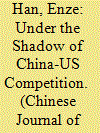| Srl | Item |
| 1 |
ID:
095593


|
|
|
|
|
| Publication |
2010.
|
| Summary/Abstract |
The decision to intervene in ongoing conflicts is one of the most difficult foreign policy choices states often face. Yet, studies of third parties' joining behavior have been rare and limited in several respects. First, they have explored only a subset of all interventions-military interventions. Second, they have concentrated on security-based determinants of intervention-power and alliance considerations-while underplaying other possible motivations behind the decision to intervene. Third, they have explored intervention and alignment choices as separate issues. This paper proposes a model of joining behavior that includes both security considerations and homophilous network ties as determinants of third parties' intervention and alignment choices. The model is tested on military and nonmilitary interventions data from Corbetta and Dixon (2005) for the 1946-2001 period. The results from a boolean logit estimation indicate that (1) the intervention decision is the result of both security-driven, pragmatic considerations and homophily between joiners and disputants; and (2) opposition to a party in a conflict is as important as a third party's social proximity to the side being supported.
|
|
|
|
|
|
|
|
|
|
|
|
|
|
|
|
| 2 |
ID:
158259


|
|
|
|
|
| Summary/Abstract |
With the U.S. and China competing for influence in Southeast Asia, how secondary states in the region make their foreign policy choices has come under more scrutiny. It seems secondary states in the region have exerted strong will and capacity to maintain significant amount of freedom in choosing their foreign policy orientations, rather than being totally dictated by the great powers. This paper presents a detailed paired comparison of Myanmar and Thailand’s alignment policies and their consequences since the end of World War II. The paper argues that international structural factors certainly constrain the options for secondary states, but domestic politics often play a significant role in how political leaders make the alignment choices they do, which is heavily conditioned by how these leaders derive their political legitimacy. Thus, to explain the alignment choices of secondary states in Southeast Asia, we need to pay more attention to the intertwined nature between domestic political contestation and foreign policy making.
|
|
|
|
|
|
|
|
|
|
|
|
|
|
|
|